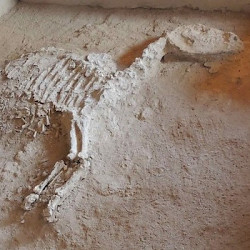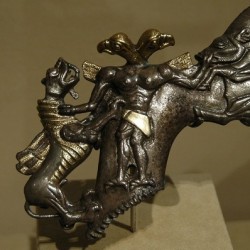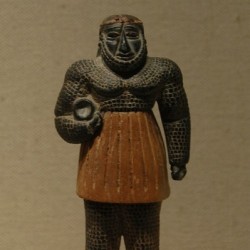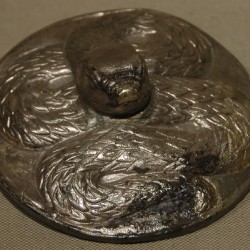Margiana
Q154974Margiana (Old Persian Marguš): oasis in the Karakum desert, modern Mary (or Merv) in the southeast of Turkmenistan.
Bronze Age
Margiana was situated on the boards of the river Murghab; this river, which was called Margos by the ancient Greeks, has its sources in the mountains of Afghanistan and flows to the north, into the Karakum desert, where it divides into several branches that disappear in the desert sands. The fertile delta was called Margiana and was already occupied by farmers in about 2200-1700 BCE; their Bronze Age culture is known as the "Bactria-Margiana Archaeological Complex". Among the sites are Altyn Deppe, Gonur Deppe, Namazga Deppe, and Ulug Deppe.
In the Avesta, Margiana is mentioned as one of Ahuramazda's special creations and called "the strong, holy Môuru".note In the Hindu, Parsi and Arab traditions, Margiana is identified with the ancient Paradise.
Little is known about the Iron Age.
Persian Age
Margiana must have been conquered by the Persian king Cyrus the Great. This is not written in our sources, but is implied by the fact that he fought against the Massagetes, a nomad tribe living beyond Margiana.
In March 522 BCE, a Magian named Gaumâta seized power in the Achaemenid empire, claiming to be the brother of the legitimate king Cambyses. (Gaumâta could do this, because this brother, Smerdis, had been killed secretly.) Immediately, Cambyses advanced to the usurper, but he died before he reached Persia; the false Smerdis was able to rule for several months. However, Cambyses' relative Darius, together with six Persian noblemen, killed the usurper (29 September). Darius became king and faced a serious crisis: nearly all provinces of the Achaemenid empire revolted. The most important rebellion was that of the Medes, whose leader was king Phraortes. His rebellion spread to the north to Armenia and to the east to Parthia. Even further to the east, the oasis of Margiana revolted.
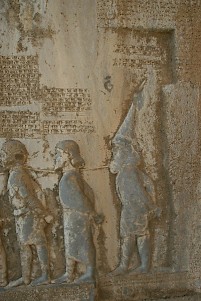
The leader of the Margian insurrection was one Frâda. Because Margiana was not a very important part of the Achaemenid empire, no action was undertaken. At the end of the spring of 521, however, the Medes had been defeated and in July the Parthian rebellion had been suppressed; only some mopping up operations were needed to restore order in the Achaemenid empire. The satrap of Bactria, Dâdarši, advanced against the rebels, which he defeated on 28 December 521 after a march of three hundred kilometers through the Karakum desert.
In the Behistun inscription, which was made immediately after the above mentioned events, Dâdarši's victory is presented as if it was just as important as the victories over the rebels in Babylonia or Media. One version of the text (the Aramaic, which is severely damaged) even mentions 55.423 Margians killed and 6.972 taken captive, which is certainly exaggerated.
Hellenistic Age
We hear from it again in the histories of the Persian campaign of the Macedonian king Alexander the Great. After the collapse of the Achaemenid empire, a Bactrian nobleman named Spitamenes started a guerilla war against the invaders (in 329/328 BCE), trying to keep Bactria and Sogdia free from Macedonian occupation. Alexander pursued the Bactrian leader, who retreated to the north, and sent his general Craterus to the west, to fortify Margiana. This was necessary, because in doing so, Spitamenes could no longer attack Alexander in the rear, in Aria. Craterus founded a city called Alexandria and fortified five other towns, all situated on defendable hills.
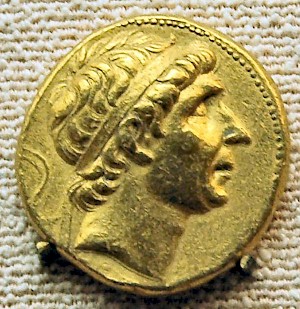
Alexandria was refounded by king Antiochus I Soter (281-261), who called it Antiochia. It was a large, square military settlement, intended to guard Iran against incursions from nomad tribes, such as the Parni, who were to overrun this region and to found the Parthian empire in what is now Iran and Iraq. (The acropolis is now known as Erk Kala; the walled city is called Gyaur Kala.)
In 53 BCE, Antiochia in Margiana received new settlers: ten thousand Roman soldiers, taken captive by the Parthians at Carrhae. They must have found the conditions of their captivity easier than they expected; a few years later, the Greek topographer Strabo of Amasia praises Margiana as a country especially blessed by nature.
In the second century CE, Margiana played a role in the trade between east and west. Coming from China, caravans arrived in Sogdia and continued through the desert to Margiana, from where they went to the Parthian empire and finally the Mediterranean. The trade route became known as the Silk road. Margiana flourished and grew rich on the trade revenues. It had its own coins and became a cultural center of great importance, where Zoroastrians, Buddhists, Jews, and (from the late fifth century) Christians lived together. It also played a role in the spread Christianity: in the sixth century, Nestorian missionaries moved from Ctesiphon through Margiana to Maracanda and China.
